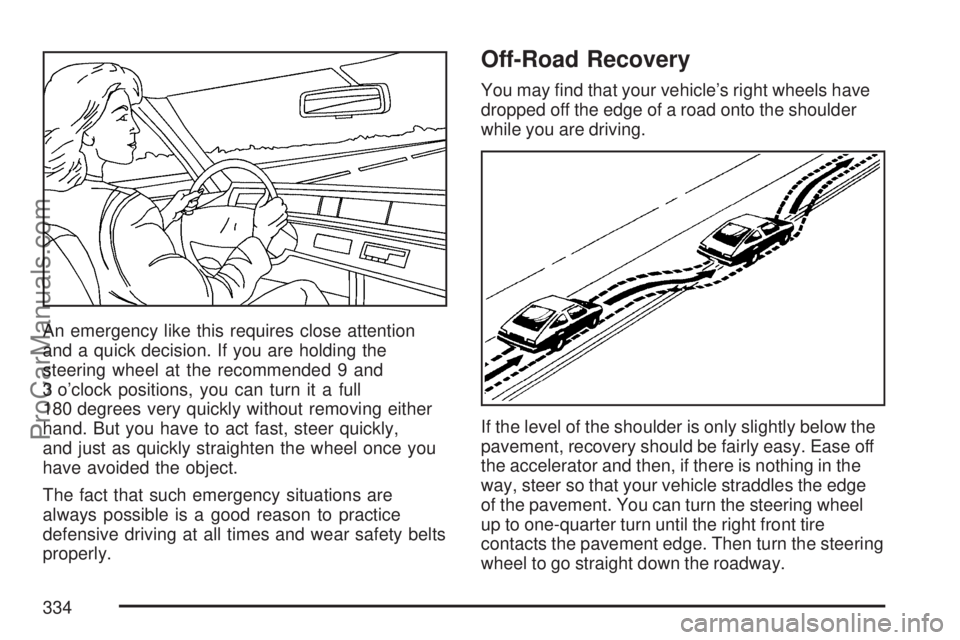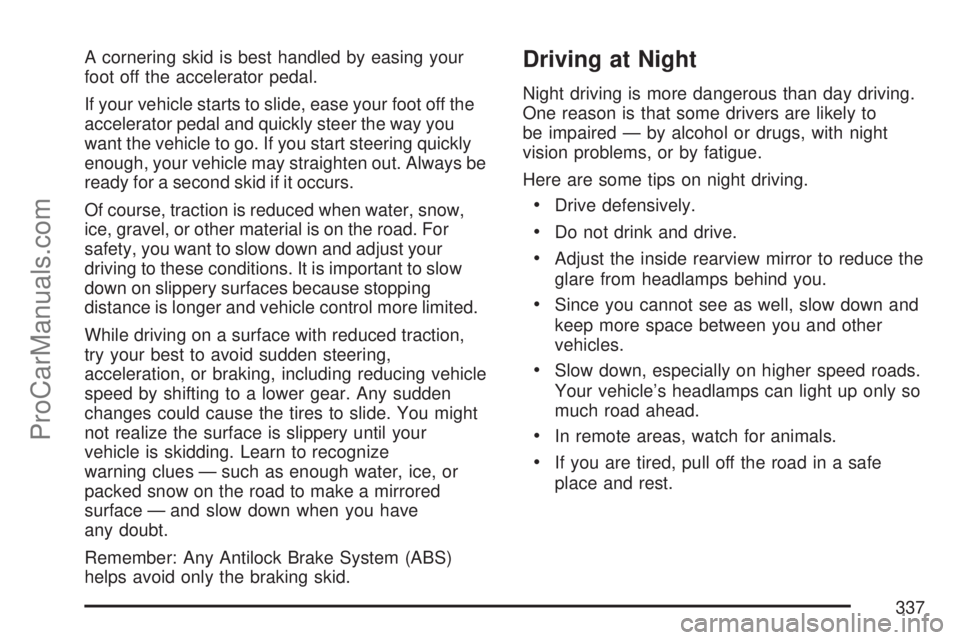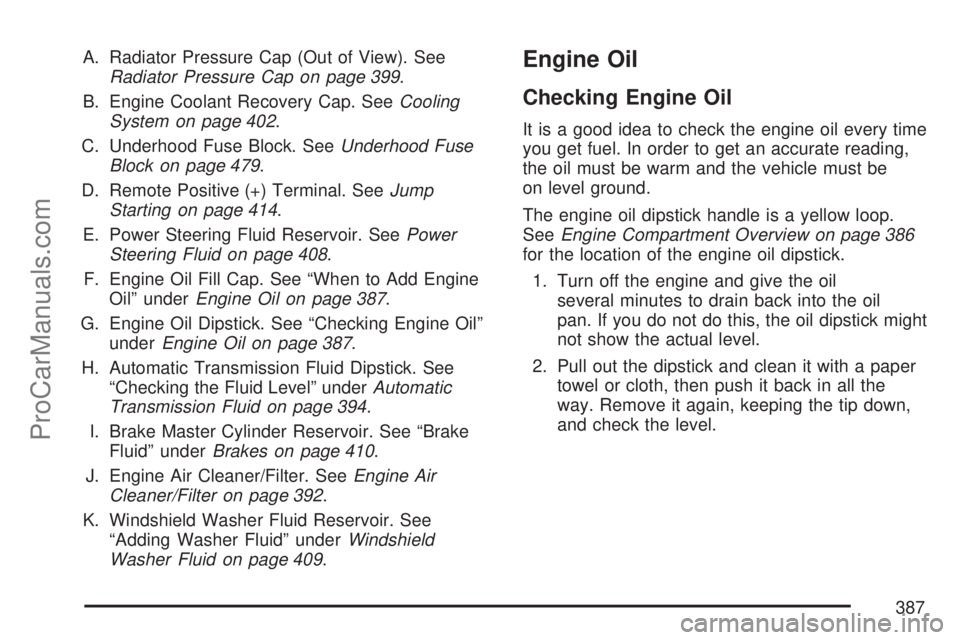steering SATURN OUTLOOK 2007 Owner's Guide
[x] Cancel search | Manufacturer: SATURN, Model Year: 2007, Model line: OUTLOOK, Model: SATURN OUTLOOK 2007Pages: 538, PDF Size: 3.2 MB
Page 333 of 538

Adding the sudden acceleration can demand too
much of those places. You can lose control.
SeeStabiliTrak
®System on page 329.
What should you do if this ever happens? Ease up
on the accelerator pedal, steer the vehicle the
way you want it to go, and slow down.
Speed limit signs near curves warn that you
should adjust your speed. Of course, the posted
speeds are based on good weather and road
conditions. Under less favorable conditions you will
want to go slower.
If you need to reduce your speed as you approach
a curve, do it before you enter the curve, while
the front wheels are straight ahead.
Try to adjust your speed so you can “drive”
through the curve. Maintain a reasonable, steady
speed. Wait to accelerate until you are out of
the curve, and then accelerate gently into
the straightaway.
Adding non-dealer/non-retailer accessories can
affect your vehicle’s performance. SeeAccessories
and Modifications on page 377.
Steering in Emergencies
There are times when steering can be more
effective than braking. For example, you come
over a hill and �nd a truck stopped in your lane, or
a car suddenly pulls out from nowhere, or a
child darts out from between parked cars and
stops right in front of you. You can avoid these
problems by braking — if you can stop in time. But
sometimes you cannot; there is not room. That
is the time for evasive action — steering around
the problem.
Your vehicle can perform very well in emergencies
like these. First, apply the brakes. SeeBraking
on page 326. It is better to remove as much speed
as you can from a possible collision. Then steer
around the problem, to the left or right depending
on the space available.
333
ProCarManuals.com
Page 334 of 538

An emergency like this requires close attention
and a quick decision. If you are holding the
steering wheel at the recommended 9 and
3 o’clock positions, you can turn it a full
180 degrees very quickly without removing either
hand. But you have to act fast, steer quickly,
and just as quickly straighten the wheel once you
have avoided the object.
The fact that such emergency situations are
always possible is a good reason to practice
defensive driving at all times and wear safety belts
properly.
Off-Road Recovery
You may �nd that your vehicle’s right wheels have
dropped off the edge of a road onto the shoulder
while you are driving.
If the level of the shoulder is only slightly below the
pavement, recovery should be fairly easy. Ease off
the accelerator and then, if there is nothing in the
way, steer so that your vehicle straddles the edge
of the pavement. You can turn the steering wheel
up to one-quarter turn until the right front tire
contacts the pavement edge. Then turn the steering
wheel to go straight down the roadway.
334
ProCarManuals.com
Page 336 of 538

If other vehicles are lined up to pass a slow
vehicle, wait your turn. But take care that
someone is not trying to pass you as you pull
out to pass the slow vehicle. Remember to
glance over your shoulder and check the
blind spot.
Check your vehicle’s mirrors, glance over your
shoulder, and start your left lane change signal
before moving out of the right lane to pass.
When you are far enough ahead of the passed
vehicle to see its front in your vehicle’s inside
mirror, activate the right lane change signal and
move back into the right lane. Remember that
an outside convex mirror makes the vehicle you
just passed seem farther away from you than it
really is.
Try not to pass more than one vehicle at a time
on two-lane roads. Reconsider before passing
the next vehicle.
Do not overtake a slowly moving vehicle too
rapidly. Even though the brake lamps are not
�ashing, it might be slowing down or starting
to turn.
If you are being passed, make it easy for the
following driver to get ahead of you. Perhaps
you can ease a little to the right.
Loss of Control
Let us review what driving experts say
about what happens when the three control
systems — brakes, steering, and
acceleration — do not have enough friction
where the tires meet the road to do what the
driver has asked.
In any emergency, do not give up. Keep trying to
steer and constantly seek an escape route or
area of less danger.
Skidding
In a skid, a driver can lose control of the vehicle.
Defensive drivers avoid most skids by taking
reasonable care suited to existing conditions, and
by not overdriving those conditions. But skids
are always possible.
The three types of skids correspond to your
vehicle’s three control systems. In the braking skid,
the wheels are not rolling. In the steering or
cornering skid, too much speed or steering in a
curve causes tires to slip and lose cornering force.
And in the acceleration skid, too much throttle
causes the driving wheels to spin.
336
ProCarManuals.com
Page 337 of 538

A cornering skid is best handled by easing your
foot off the accelerator pedal.
If your vehicle starts to slide, ease your foot off the
accelerator pedal and quickly steer the way you
want the vehicle to go. If you start steering quickly
enough, your vehicle may straighten out. Always be
ready for a second skid if it occurs.
Of course, traction is reduced when water, snow,
ice, gravel, or other material is on the road. For
safety, you want to slow down and adjust your
driving to these conditions. It is important to slow
down on slippery surfaces because stopping
distance is longer and vehicle control more limited.
While driving on a surface with reduced traction,
try your best to avoid sudden steering,
acceleration, or braking, including reducing vehicle
speed by shifting to a lower gear. Any sudden
changes could cause the tires to slide. You might
not realize the surface is slippery until your
vehicle is skidding. Learn to recognize
warning clues — such as enough water, ice, or
packed snow on the road to make a mirrored
surface — and slow down when you have
any doubt.
Remember: Any Antilock Brake System (ABS)
helps avoid only the braking skid.Driving at Night
Night driving is more dangerous than day driving.
One reason is that some drivers are likely to
be impaired — by alcohol or drugs, with night
vision problems, or by fatigue.
Here are some tips on night driving.
Drive defensively.
Do not drink and drive.
Adjust the inside rearview mirror to reduce the
glare from headlamps behind you.
Since you cannot see as well, slow down and
keep more space between you and other
vehicles.
Slow down, especially on higher speed roads.
Your vehicle’s headlamps can light up only so
much road ahead.
In remote areas, watch for animals.
If you are tired, pull off the road in a safe
place and rest.
337
ProCarManuals.com
Page 349 of 538

Whatever the condition — smooth ice, packed,
blowing, or loose snow — drive with caution.
StabiliTrak
®improves your ability to accelerate
when driving on a slippery road. Even with
StabiliTrak
®, slow down and adjust your driving to
the road conditions. Under certain conditions,
you might want to turn the traction control part of
the StabiliTrak
®System off, such as when
driving through deep snow and loose gravel, to
help maintain vehicle motion at lower speeds. See
StabiliTrak
®System on page 329andIf Your
Vehicle is Stuck in Sand, Mud, Ice, or Snow on
page 352.The Antilock Brake System (ABS) improves your
vehicle’s stability when you make a hard stop
on a slippery road. Even though you have ABS,
begin stopping sooner than you would on dry
pavement. SeeAntilock Brake System (ABS) on
page 327.
Allow greater following distance on any
slippery road.
Watch for slippery spots. The road might be
�ne until you hit a spot that is covered with
ice. On an otherwise clear road, ice patches
can appear in shaded areas where the
sun cannot reach, such as around clumps of
trees, behind buildings, or under bridges.
Sometimes the surface of a curve or an
overpass can remain icy when the surrounding
roads are clear. If you see a patch of ice
ahead of you, brake before you are on it. Try
not to brake while you are actually on the
ice, and avoid sudden steering maneuvers.
349
ProCarManuals.com
Page 352 of 538

If Your Vehicle is Stuck in Sand,
Mud, Ice, or Snow
In order to free your vehicle when it is stuck, you
need to spin the wheels, but you do not want
to spin the wheels too fast. The method known as
rocking can help you get out when you are
stuck, but you must use caution.
{CAUTION:
If you let your vehicle’s tires spin at high
speed, they can explode, and you or
others could be injured. And, the
transmission or other parts of the vehicle
can overheat. That could cause an engine
compartment �re or other damage. When
you are stuck, spin the wheels as little as
possible. Do not spin the wheels above
35 mph (55 km/h) as shown on the
speedometer.Notice:Spinning the wheels can destroy parts
of your vehicle as well as the tires. If you
spin the wheels too fast while shifting
the transmission back and forth, you can
destroy the transmission.
For information about using tire chains on your
vehicle, seeTire Chains on page 445.
Rocking Your Vehicle to Get It Out
First, turn the steering wheel left and right to clear
the area around the front wheels. Turn the
traction control part of the StabiliTrak
®System off.
SeeStabiliTrak®System on page 329. Then
shift back and forth between REVERSE (R) and a
forward gear, spinning the wheels as little as
possible. To prevent transmission wear, wait until
the wheels stop spinning before shifting gears.
Release the accelerator pedal while you shift, and
press lightly on the accelerator pedal when the
transmission is in gear. By slowly spinning
the wheels in the forward and reverse directions,
you will cause a rocking motion that could free
your vehicle. If that does not get your vehicle out
after a few tries, it might need to be towed
out. If your vehicle does need to be towed out,
seeTowing Your Vehicle on page 358.
352
ProCarManuals.com
Page 361 of 538

Dolly Towing (Front-Wheel-Drive
Vehicles Only)
To tow your front-wheel-drive vehicle from the
front with two wheels on the ground:
1. Put the front wheels on a dolly.
2. Move the shift lever to PARK (P).
3. Set the parking brake and then remove the key.
4. Clamp the steering wheel in a straight-ahead
position with a clamping device designed for
towing.
5. Release the parking brake.
Towing Your Vehicle From the Rear
Notice:Towing your vehicle from the rear
could damage it. Also, repairs would not
be covered by the warranty. Never have your
vehicle towed from the rear.
Do not tow your vehicle from the rear.
361
ProCarManuals.com
Page 370 of 538

Driving with a Trailer
Towing a trailer requires a certain amount of
experience. Before setting out for the open road,
you’ll want to get to know your rig. Acquaint
yourself with the feel of handling and braking with
the added weight of the trailer. And always
keep in mind that the vehicle you are driving is
now a good deal longer and not nearly as
responsive as your vehicle is by itself.
Before you start, check all trailer hitch parts and
attachments, safety chains, electrical connector,
lamps, tires and mirror adjustment. If the trailer has
electric brakes, start your vehicle and trailer
moving and then apply the trailer brake controller
by hand to be sure the brakes are working.
This lets you check your electrical connection at
the same time.
During your trip, check occasionally to be sure
that the load is secure, and that the lamps and any
trailer brakes are still working.
Following Distance
Stay at least twice as far behind the vehicle ahead
as you would when driving your vehicle without
a trailer. This can help you avoid situations
that require heavy braking and sudden turns.
Passing
You’ll need more passing distance up ahead when
you’re towing a trailer. And, because you’re a
good deal longer, you’ll need to go much farther
beyond the passed vehicle before you can
return to your lane.
Backing Up
Hold the bottom of the steering wheel with one
hand. Then, to move the trailer to the left,
just move that hand to the left. To move the trailer
to the right, move your hand to the right. Always
back up slowly and, if possible, have someone
guide you.
370
ProCarManuals.com
Page 375 of 538

Service........................................................ 377
Accessories and Modi�cations................... 377
California Proposition 65 Warning.............. 378
Doing Your Own Service Work.................. 378
Adding Equipment to the Outside of
Your Vehicle.......................................... 379
Fuel............................................................. 379
Gasoline Octane........................................ 379
Gasoline Speci�cations.............................. 379
California Fuel........................................... 380
Additives................................................... 380
Fuels in Foreign Countries........................ 381
Filling the Tank......................................... 381
Filling a Portable Fuel Container............... 384
Checking Things Under the Hood.............. 384
Hood Release........................................... 385
Engine Compartment Overview.................. 386
Engine Oil................................................. 387
Engine Oil Life System.............................. 390
Engine Air Cleaner/Filter............................ 392
Automatic Transmission Fluid.................... 394
Engine Coolant.......................................... 396
Radiator Pressure Cap.............................. 399
Engine Overheating................................... 400Overheated Engine Protection
Operating Mode..................................... 402
Cooling System......................................... 402
Power Steering Fluid................................. 408
Windshield Washer Fluid........................... 409
Brakes...................................................... 410
Battery...................................................... 413
Jump Starting............................................ 414
All-Wheel Drive........................................... 420
Headlamp Aiming........................................ 421
Bulb Replacement....................................... 422
High Intensity Discharge (HID) Lighting..... 422
Halogen Bulbs........................................... 422
License Plate Lamp................................... 423
Replacement Bulbs................................... 423
Windshield Wiper Blade Replacement....... 424
Tires............................................................ 425
Tire Sidewall Labeling............................... 426
Tire Terminology and De�nitions............... 429
In�ation - Tire Pressure............................. 432
Tire Pressure Monitor System................... 433
Tire Inspection and Rotation...................... 438
When It Is Time for New Tires.................. 440
Section 5 Service and Appearance Care
375
ProCarManuals.com
Page 387 of 538

A. Radiator Pressure Cap (Out of View). See
Radiator Pressure Cap on page 399.
B. Engine Coolant Recovery Cap. SeeCooling
System on page 402.
C. Underhood Fuse Block. SeeUnderhood Fuse
Block on page 479.
D. Remote Positive (+) Terminal. SeeJump
Starting on page 414.
E. Power Steering Fluid Reservoir. SeePower
Steering Fluid on page 408.
F. Engine Oil Fill Cap. See “When to Add Engine
Oil” underEngine Oil on page 387.
G. Engine Oil Dipstick. See “Checking Engine Oil”
underEngine Oil on page 387.
H. Automatic Transmission Fluid Dipstick. See
“Checking the Fluid Level” underAutomatic
Transmission Fluid on page 394.
I. Brake Master Cylinder Reservoir. See “Brake
Fluid” underBrakes on page 410.
J. Engine Air Cleaner/Filter. SeeEngine Air
Cleaner/Filter on page 392.
K. Windshield Washer Fluid Reservoir. See
“Adding Washer Fluid” underWindshield
Washer Fluid on page 409.Engine Oil
Checking Engine Oil
It is a good idea to check the engine oil every time
you get fuel. In order to get an accurate reading,
the oil must be warm and the vehicle must be
on level ground.
The engine oil dipstick handle is a yellow loop.
SeeEngine Compartment Overview on page 386
for the location of the engine oil dipstick.
1. Turn off the engine and give the oil
several minutes to drain back into the oil
pan. If you do not do this, the oil dipstick might
not show the actual level.
2. Pull out the dipstick and clean it with a paper
towel or cloth, then push it back in all the
way. Remove it again, keeping the tip down,
and check the level.
387
ProCarManuals.com